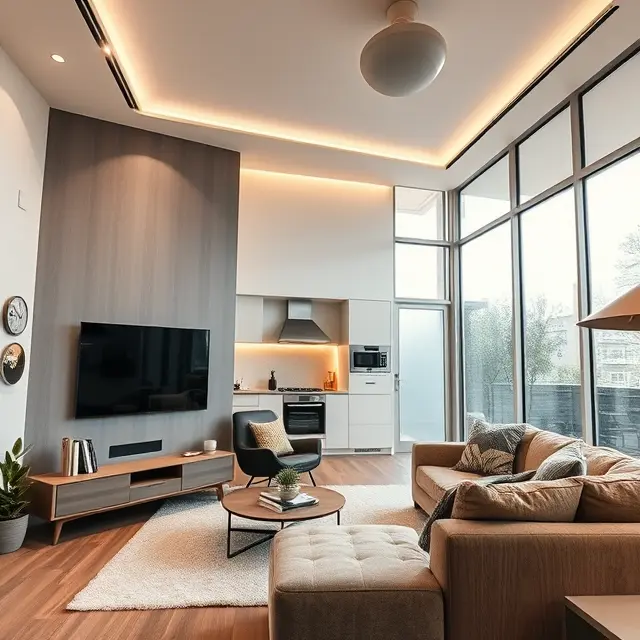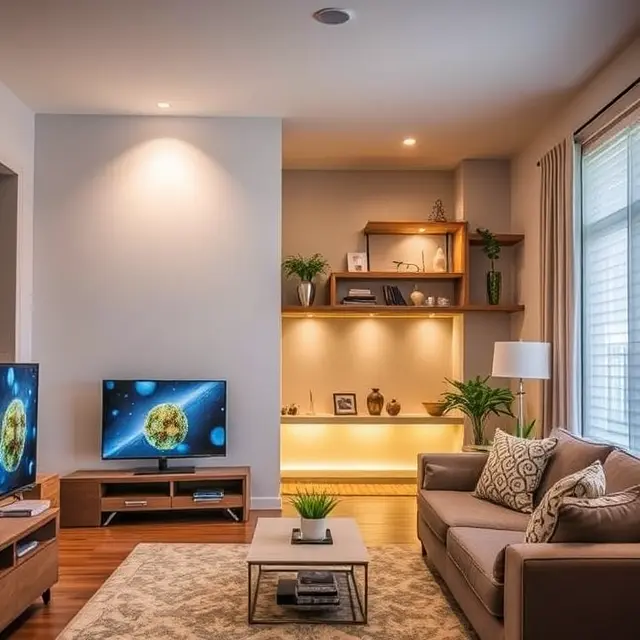
Transforming Your Living Space with Smart Home Technology
Table of Contents
ToggleTransforming Your Living Space with Smart Home Technology
Did you know over half of American households are expected to adopt smart home technology by the end of 2025? This growing trend is evident in places like Framingham, MA, where residents are embracing smart solutions to enhance their living spaces. Whether it’s improving security, automating comfort, or streamlining daily chores, smart home devices are changing how we live.
However, many homeowners are unsure where to begin. With so many options available, it can feel overwhelming to decide which devices are worth the investment. This comprehensive guide will deeply explore how smart home technology can transform your living space, covering essential devices, setup strategies, and future trends.
What is Smart Home Technology?
Smart home technology refers to internet-connected devices that automate and control various household functions. These devices allow you to manage your home remotely or automatically, enhancing comfort, security, and energy efficiency.
Examples of Smart Home Technology Include:
- Smart thermostats that adjust temperature based on your schedule.
- Smart lights that can change color and brightness through voice commands or apps.
- Smart security systems that provide real-time surveillance and alerts.
- Smart appliances that simplify household tasks, like self-cleaning ovens or robotic vacuums.
By integrating these technologies, you can create a living space tailored to your needs and lifestyle.
Benefits of Smart Home Technology

1. Convenience and Comfort
Smart devices make everyday tasks easier. Imagine adjusting your thermostat, turning off lights, or locking doors with just your smartphone or voice command. With automation, your home can anticipate your needs.
Examples:
- Set lights to turn on at sunset automatically.
- Program your coffee maker to start brewing before you wake up.
- Use voice commands to play music or adjust room temperature.
2. Energy Efficiency
Smart devices help reduce energy consumption, saving money and benefiting the environment.
Energy-Saving Devices Include:
- Smart thermostats that learn your schedule to optimize heating and cooling.
- Smart lights that turn off when you leave a room.
- Energy monitoring plugs that track how much energy your devices use.
3. Enhanced Security
Smart home security systems provide peace of mind. They allow you to monitor your home in real time, get alerts about suspicious activity, and control security devices remotely.
Key Devices:
- Smart cameras for indoor and outdoor surveillance.
- Smart doorbells that let you see and talk to visitors remotely.
- Smart locks that allow keyless entry.
4. Remote Access and Control
You can control your smart home devices from anywhere using your smartphone or tablet. This is ideal for travelers or busy homeowners.
Examples:
- Lock or unlock doors remotely.
- Check security cameras while on vacation.
- Adjust the thermostat before arriving home.
5. Customization and Flexibility
Smart home technology is highly customizable. You can create personalized routines to suit your daily schedule.
Examples:
- A “Good Morning” routine that gradually brightens lights, starts the coffee maker, and reads out the weather.
- A “Good Night” routine that turns off lights, locks doors, and adjusts the thermostat.
Essential Smart Home Devices to Upgrade Your Living Space
1. Smart Lighting Systems
Smart lighting gives you complete control over your home’s ambiance and energy usage.
Key Features:
- Remote Control: Use an app to turn lights on or off.
- Voice Commands: Control lights with Alexa, Google Assistant, or Siri.
- Scheduling: Automate lights to fit your routine.
Popular Products:
- Philips Hue: Customizable colors and brightness.
- LIFX Smart Bulbs: Wi-Fi-enabled with no hub required.
- TP-Link Kasa Smart Lights: Budget-friendly options.
Benefits:
- Reduce energy costs.
- Enhance mood and ambiance.
- Increase security with automated lighting.
2. Smart Thermostats
Smart thermostats optimize your home’s temperature for comfort and energy efficiency.
Key Features:
- Learning Algorithms: Understand your schedule and adjust automatically.
- Remote Control: Adjust temperatures from anywhere.
- Energy Reports: Track energy usage and savings.
Popular Products:
- Nest Learning Thermostat: Auto-scheduling and energy tracking.
- Ecobee SmartThermostat: Includes a smart sensor for room-specific control.
- Honeywell Home T9: Affordable and user-friendly.
Benefits:
- Lower heating and cooling bills.
- Improved comfort.
- Environmental sustainability.
Visit this site if you are looking for smart thermostat installation in Framingham, MA.
3. Smart Security Systems
Smart security systems provide 24/7 protection and peace of mind.
Key Features:
- Live Streaming: Monitor your property in real time.
- Motion Detection: Receive instant alerts.
- Two-Way Audio: Communicate with visitors remotely.
Popular Products:
- Ring Video Doorbell: See and speak to visitors.
- Arlo Pro Cameras: Wireless security cameras with cloud storage.
- August Smart Locks: Remote locking and unlocking.
Benefits:
- Deter intruders.
- Monitor packages and deliveries.
- Control access to your home.
4. Smart Home Assistants
Smart home assistants centralize control of your devices and simplify daily tasks.
Key Features:
- Voice Commands: Control devices hands-free.
- Smart Home Integration: Connect with multiple smart devices.
- Routine Automation: Combine multiple tasks into single commands.
Popular Products:
- Amazon Echo (Alexa): Supports thousands of smart home devices.
- Google Nest Hub: Voice assistant with a touchscreen.
- Apple HomePod (Siri): Best for Apple users.
Benefits:
- Simplified control of devices.
- Entertainment and information access.
- Home automation routines.
5. Smart Appliances
Smart appliances make household chores easier and more efficient.
Key Features:
- Remote Monitoring: Check appliance status via smartphone.
- Energy Efficiency: Smart operation saves energy.
- Maintenance Alerts: Notifications for upkeep.
Popular Products:
- Samsung Family Hub Refrigerator: Smart touchscreen for groceries.
- LG Smart Washer/Dryer: Remote start and energy tracking.
- iRobot Roomba Vacuum: Automated cleaning.
Benefits:
- Save time on daily chores.
- Reduce energy consumption.
- Simplify home management.
How to Start Building Your Smart Home?
Plan Your Setup: Identify your priorities—security, comfort, energy savings—and choose devices that meet those needs.
- Choose a Smart Home Ecosystem: Select a central platform like Amazon Alexa, Google Assistant, or Apple HomeKit to ensure compatibility.
- Start Small and Expand: Begin with a few devices like smart bulbs or plugs, then gradually add more complex systems like cameras and thermostats.
- Ensure Device Compatibility: Check that all devices work together to avoid integration issues.
- Secure Your Network: Use strong passwords, enable two-factor authentication, and regularly update firmware to protect your devices.
Energy Efficiency with Smart Home Technology
- Smart Thermostats: Save energy by automating heating and cooling based on your schedule.
- Smart Lighting: Use motion sensors and timers to reduce unnecessary energy use.
- Energy Monitors: Track energy use with devices like the Sense Energy Monitor.
- Smart Power Strips: Cut off power to unused devices to save energy.
Future Trends in Smart Home Technology
- AI Integration: Artificial intelligence will make devices smarter, adapting to user behavior.
- 5G Connectivity: Faster internet will improve the performance of smart devices.
- Eco-Friendly Devices: More devices will focus on sustainability and energy efficiency.
- Home Robots: Robots will handle more tasks like cleaning, security, and assistance.
Conclusion
Smart home technology can completely transform your living space, offering unmatched convenience, security, and energy efficiency. By starting with basic devices and gradually expanding, you can create a smarter, more comfortable home that suits your lifestyle. Investing in smart home technology is not just about upgrading your home—it’s about improving your daily life for the better.
FAQs
We have mentioned some of the FAQs about smart home technology.
How does smart home will improve your lifestyle?
More control over energy consumption is possible with smart houses, which also automate tasks like temperature management, light control, window treatment opening and shutting, and weather-based irrigation.
What are 5 reasons for a smart house?
Five Justifications for Choosing Smart Home Technology
- Convenience and comfort
- energy efficiency
- Security and safety
- Adaptability and personalization
- Home management tips
How does smart home technology help the environment?
An important aspect of environmental sustainability is energy efficiency, which is greatly enhanced by smart home technologies. These technologies aid in the reduction of overall energy use by automating, optimizing, and integrating a variety of home tasks.
What is the aim of smart home?
Important Takeaways. With a smartphone or tablet and an internet connection, homeowners may remotely control lights, thermostats, appliances, and other equipment in a smart home. Both hardwired and wireless technologies can be installed in smart homes. Smart home technology saves money and offers convenience to homeowners.
What are examples of smart devices?
Smart watches, smart bands, smart keychains, smart glasses, phones, smart speakers, smart automobiles, smart thermostats, smart doorbells, smart locks, smart refrigerators, phablets, tablets, and many more are examples of noteworthy smart gadget kinds.
You May Also Like

The Rise of Low-Code/No-Code Platforms in Web Design
18 February 2025
Aircon Services: Keeping Your AC Efficient
4 January 2025

